Nonmydriatic cameras make fundus exams more patient, practice friendly
Click Here to Manage Email Alerts
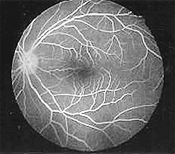
 ---Fluorescein images from the Canon CR6-45NMf show the 45º view the camera offers (left) and the magnification capabilities of the digital imaging system (right).
---Fluorescein images from the Canon CR6-45NMf show the 45º view the camera offers (left) and the magnification capabilities of the digital imaging system (right).
Today’s nonmydriatic cameras make fundus photography far more patient-friendly by eliminating the need for bright lights and dilating drops. In turn, eliminating the 30-minute wait for the pupil to dilate and the time for the eye to adjust following a flash of light speeds the exam. This further benefits the patient and saves time for the practitioner and office staff, an important feature in the managed care environment. This feature also is helpful with glaucoma patients for whom dilation is contraindicated.
The addition of digital image capture systems allows practitioners to immediately view fundus photos and share them with the patient to illustrate pathology or problem areas during the exam. This feature is a valuable addition as the images can be transmitted via e-mail for referral or consultation, facilitating the trend toward tele-health.
Canon adds fluorescein imaging
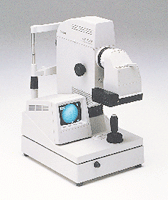 ---Canon has improved on the CR6-45NM, shown here, by adding the ability to take color photographs and fluorescien images on the same camera with its new CR6-45NMf.
---Canon has improved on the CR6-45NM, shown here, by adding the ability to take color photographs and fluorescien images on the same camera with its new CR6-45NMf.
Canon U.S.A. Inc., which manufactured its first nonmydriatic camera in 1976, has improved its CR6-45NM Non-Mydriatic Retinal Camera by adding the ability to take both full-color and fluorescein images. The new model is the CR6-45NMf.
This new feature is especially beneficial in high-traffic clinics, where one system is frequently dedicated to producing color photos, while the patient is then taken to a separate mydriatic camera for taking fluorescein images, said Ronald Kaiser, assistant director of Canon’s medical products division.
“This allows you to do the screenings as a nonmydriatic exam, and if you see something, you can do your fluorescein right away and document what you saw,” Mr. Kaiser said.
The Canon fundus camera is used at the East Orange Veterans Hospital in New Jersey, primarily to screen patients for diabetes, said Ben Szirth, PhD, tele-ophthalmology consultant. The ability to complete the exam quickly and without dilating makes patients more willing to undergo the procedure, increasing the chances of catching diabetes at an earlier stage.
“Previously, we had to use two cameras. This way we don’t have to move the patient to another camera; some of our patients are elderly and difficult to move,” Dr. Szirth said.
Because the camera is designed to operate with reduced lighting, less dye is required to obtain a fluorescein image, making it more tolerable for the patient, Mr. Kaiser said.
Colored filters increase capabilities
Doctors at the hospital experimenting with the Canon have found that adding different colored filters prior to injecting fluorescein increases its diagnostic capabilities, Dr. Szirth said.
“Drusen, for example, are hyperfluorescent, so if we use a cobalt filter alone without the barrier filter, we would know that it is in fact drusen, and not some other material. The filters also allow us to penetrate different parts of the retina. Cobalt blue brings out the nerve fiber layers. Green would show us all the layers of the retina and red would show the choroid,” he said.
Also unique to the Canon instrument is a movable internal fixation target light that can be enlarged up to four times its original size.
“If the light is in one position only, you really can’t scan the eye looking for other pathology,” Mr. Kaiser said. “The light being movable gives you that option, and it’s done really quickly, so the patient is willing to go along with it.”
The larger size target helps low vision patients and could alert the doctor or technician to a pathology that had not been previously detected, he added.
The ability to print images, store them on a compact disk or send them via the Internet from the Veterans Hospital to a retinal specialist at the New Jersey Medical School in Newark speeds up the referral process, Dr. Szirth said. The electronic referral allows follow-up appointments to be scheduled quickly for patients who may be suspected of having diabetes.
The camera is easy to use with little training; operators can focus by using a video monitor next to the camera instead of an eyepiece, Dr. Szirth said.
The camera offers 30º and 45º fields of view on Polaroid film and 45º and 22.5º by utilizing the CR-TA or CR-TAf video adapter.
Nidek’s camera is portable
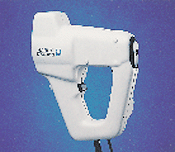 ---The Handy NM-100 requires 95% less flash than standard mydriatic cameras and has a camera head that weighs just 3 pounds, making it easily movable from office to office or off-site.
---The Handy NM-100 requires 95% less flash than standard mydriatic cameras and has a camera head that weighs just 3 pounds, making it easily movable from office to office or off-site.
Nidek Inc.’s Handy NM-100 Non-Mydriatic Fundus Camera offers the advantage of portability. The camera head weighs 3 pounds, while the processing unit, including the power supply and a 5-inch color liquid crystal display (LCD) screen, weighs about 26 pounds.
This portability was a significant advantage for Nick Neagle, OD, in practice in Washington. “I personally like it because I have three offices, and I can take it around to all three offices. The portability makes the investment worthwhile,” Dr. Neagle said.
Adjusting to the camera after being accustomed to traditional stationary equipment was an obstacle at first, but quickly overcome, he added.
“The other cameras are tabletop models, as with most optometric and ophthalmic equipment,” Dr. Neagle said. “Patients are very stable because they have their heads fixed up against head rests and chin rests, and you don’t have to worry about any movement. With this, the patient is moving, you’re moving, the camera is moving. It takes a little dexterity to get everything lined up, but once you get used to how that works, then it’s perfectly fine.
“As with any camera, if you are going to focus on particular types of pathology, you have to learn how to control the background lighting,” he added.
The NM-100 is an analog camera with infrared illumination that acquires the retinal image using a flash intensity about 90% less than the traditional fundus camera, said Thomas R. Russo, diagnostic sales specialist.
This allows practitioners to acquire images on both eyes within 1 minute. Multiple images can be taken on the same eye without causing any type of pupil constriction or patient discomfort, because the flash intensity is so low, Dr. Neagle said.
“Another positive thing about this is that the flash on a traditional camera is so bright it is almost painful,” he said. “Because this is a low-level white light flash, you can flash as often as you like, and it won’t bother the patient.”
The field of view on the NM-100 is 30º. When the picture is taken, the 30º view is instantly captured on the LCD display, allowing the doctor to show the patient any dystrophy, Mr. Russo said.
The processing unit can be connected to a printer, allowing the doctor to print the image or use a video capture card to acquire the image electronically to store or e-mail, facilitating tele-health referrals.
Optos receives 510k approval
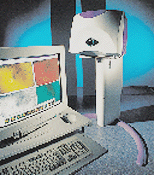 ---The Optos Panoramic 200 Non Mydriatic Ophthalmoscope employs two lasers and an ellipsoidal mirror to scan a 200º internal angle of the eye.
---The Optos Panoramic 200 Non Mydriatic Ophthalmoscope employs two lasers and an ellipsoidal mirror to scan a 200º internal angle of the eye.
Optos is developing a new approach to fundus imaging and diagnostic screening that has just received 510k approval by the Food and Drug Administration (FDA). The Panoramic 200 Non Mydriatic Ophthalmoscope from Optos, based in Dunfermline, Scotland, uses coaxial laser beams consisting of red and green wavelengths — each of which excites a different layer of the retina — to provide an ultra-wide field color image of almost the entire retina.
“The scan system generates a very fast, very precise beam, which it projects onto the ellipsoidal mirror, which is in turn projected onto the back of the eye,” said Douglas Anderson, founder and chief executive officer of Optos. “The reflection of that beam is then captured by the ellipsoidal mirror and returned to the scanning system, where it is de-scanned.”
The beam passes through the pupil, scanning a 200º internal angle of the retina, capturing the optic disc, macula, superior and inferior arcades up to the vortex veins and, in some patients, the ora serrata. The images acquired by each beam are then combined into a single 2,000 × 2,000-pixel image by a computer. Total image capture requires only 0.25 seconds for each eye, and the process is nearly imperceptible to the patient.
The manufacturer plans to add a third laser to the device, which would require additional FDA approval, said Steve Guida, president of North American operations, based in Westborough, Mass. A blue wavelength laser has been tested, but added little to the image, and an infrared wavelength is being studied.
The Panoramic 200 operates in dim room light and does not require a flash, so there is no need to allow one eye to adjust after an image is taken of the other, said William Jones, OD, who has been involved in the clinical trials of the system. The image can be taken directly from the camera and sent to a monitor in the exam room or sent via e-mail to another site.
“One disadvantage is that this system does not support stereopsis, so it produces flat plane images, and this is found in all current systems on a single shot image capture,” Dr. Jones said. “Currently, computer digital capture images will not allow stereopsis, only slides or other images viewed with some disparity technique.”
The first units are scheduled to be delivered this month to beta research sites near the company’s Scotland headquarters, then to research sites in Boston, Atlanta and Pittsburgh a week later, Mr. Guida said. The company expects commercial sales to begin in the United States by midyear.
Per use payment
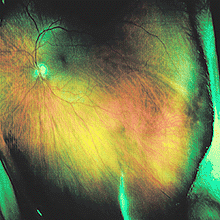 ---The ora serrata is part of the wider fundus view offered by the Optos Panoramic 200 Non Mydriatic Ophthalmoscope.
---The ora serrata is part of the wider fundus view offered by the Optos Panoramic 200 Non Mydriatic Ophthalmoscope.
The Panoramic 200 will not be sold as a piece of capital equipment, Mr. Guida said. Fees for using the equipment will be collected on a per-patient basis.
“We will qualify practitioners as good potential sites, deliver the equipment and train them to use it. They pay as they use it, so there is not a huge capital investment on their part. This will make the technology accessible to more people,” Mr. Guida said.
Sites will be selected on the basis of patient flow, which should be about 100 to 200 patients per month, and the practitioner’s strong desire to have the Panoramic 200 integrated into the practice, Mr. Guida said.
“The most suitable practices are those that can also see the benefit of growing their own practice and attracting more patients because this frees up a lot of time,” Mr. Guida continued. “Patients want to be examined and imaged well, because a very key part of patient care is to get a good view of the back of the eye and diagnose disease earlier.”
Live-action system soon available
 ---The Digitial Fundus Imager from Ophthalmic Imaging Systems will allow practitioners to record their exam in a live-action, dynamic format.
---The Digitial Fundus Imager from Ophthalmic Imaging Systems will allow practitioners to record their exam in a live-action, dynamic format.
Ophthalmic Imaging Systems (OIS) launched its Digital Fundus Imager at the American Academy of Optometry meeting, and initial deliveries are scheduled for May. This camera requires dilation, but less than that required by traditional mydriatic cameras because its propietary design projects a pinpoint of light, said Christine Ritter Randle, vice president of marketing. The camera, for both color imaging and fluorescein angiography, operates in low-light situations and does not require a flash.
Unlike other cameras, OIS captures a live-action dynamic picture of the eye, documenting the entire exam, Ms. Randle said. The camera offers real-time feedback, allowing the user to see exactly what is being recorded. Individual frames of the video clip also can be captured, printed and transmitted electronically.
The live-action capture system is a valuable diagnostic tool, said Michael M. Cohen, OD, an optometric consultant involved with the development of the camera.
“You can scan the entire optic nerve head and then play it back at your earliest convenience to really take a detailed view of the fundus,” Dr. Cohen said. Capturing a video of the entire exam also eliminates the possibility of missing an ideal shot to illustrate a problem area, he said.
“If you do fundus photography, you find that, in a lot of cases, you never get the picture you want. You see it, and by the time you hit the flash, the patient has blinked or moved. Here you don’t have that worry. Because you’ve taken a whole video, you can select the frame that best shows what you’re looking for and make a picture from that,” Dr. Cohen said.
The camera features two fields of view: 25º and 40º, both of which can be panned across the retina to simulate the view of an ophthalmoscopic exam. The movement of the camera provides a stereo image of the optic nerve head, giving depth to the image.
For Your Information:
- Ronald Kaiser, assistant director of Canon’s medical products division, can be contacted at Canon U.S.A. Inc., One Canon Plaza, Lake Success, NY 11042-1198; (516) 328-5000; fax: (516) 328-4639; e-mail: rkaiser@cusa.canon.com.
- Ben Szirth, PhD, can be contacted at the Department of Ophthalmology, New Jersey Medical School, 90 Bergen St., Room 6157, Newark, NJ 07103-2499; fax: (973) 972-2068; e-mail: eyeszirth@aol.com. Dr. Szirth has no direct financial interest in the products mentioned in this article, nor is he a paid consultant for any companies mentioned.
- Nick Neagle, OD can be contacted at 424 L’Enfant Plaza SW, Washington, DC 20024; (202) 554-4248; fax: (202) 554-2376; web site: www.goodsight.com/drneagle. Dr. Neagle has no direct financial interest in the products mentioned in this article, nor is he a paid consultant for any companies mentioned.
- Thomas R. Russo can be contacted at 441 N. Oak Ave., Clifton Heights, PA 19018; (888) 626-4590, (610) 626-6322; fax: (510) 226-5750. Mr. Russo has a direct financial interest in the Handy NM-100 and is a paid consultant for Nidek Inc.
- Douglas Anderson, chief executive officer of Optos, can be reached at 16 Comely Park, Dunfermline, Fife, KY12 7HU, Scotland, UK; (44) 1383 628714; fax: (44) 1383 628706; e-mail: danderson@optos.com.
- Steve Guida is president of Optos North America and can be contacted at 112 Turnpike Rd., Ste. 111, Westborough, MA 01581; (800) 854-3039; fax: (508) 870-9911; e-mail: sguida@msn.com.
- William Jones, OD, is a charter member of the Primary Care Optometry News Editorial Board and can be contacted at 1828 Conestoga SE, Albuquerque, NM 87123; (505) 293-7347; e-mail: wm_jones@msn.com. Dr. Jones has a direct financial interest in the Panoramic 200 Mydriatic Ophthalmoscope and is a paid consultant for Optos.
- Christine Ritter Randle, vice president of marketing for Ophthalmic Imaging Systems, can be contacted at 221 Lathrop Way, Ste. I, Sacramento, CA 95815; (800) 338-8436, (916) 646-2020; fax: (916) 646-0207.
- Michael M. Cohen, OD, can be contacted at 1401 Via Loma, Walnut Creek, CA 94598; (925) 945-0432; fax: (925) 945-8201; e-mail: michael@mmcohen.com. Dr. Cohen has a direct financial interest in the Digital Imaging System and is a paid consultant for Ophthalmic Imaging Systems.
- The CR6-45NMf Non-Mydriatic Retinal Camera is available from Canon U.S.A. Inc., One Canon Plaza, Lake Success, NY 11042-1198; (516) 328-5000; fax: (516) 328-4639.
- The Portable Non-Mydriatic Fundus Camera is available from Nidek Inc., 47651 Westinghouse Dr., Fremont, CA 94539; (800) 223-9044, (510) 226-5700; fax: (510) 226-5750; web site: www.nidek.com.
- For information on the Panoramic 200 Non Mydriatic Ophthalmoscope, contact Optos at 112 Turnpike Rd., Ste. 111, Westborough, MA 01581; (800) 854-3039; fax: (508) 870-9911; e-mail: info@optos.com.
- For information on the Digital Fundus Imager, contact Ophthalmic Imaging Systems at 221 Lathrop Way, Ste. I, Sacramento, CA 95815; (800) 338-8436, (916) 646-2020; fax: (916) 646-0207.
